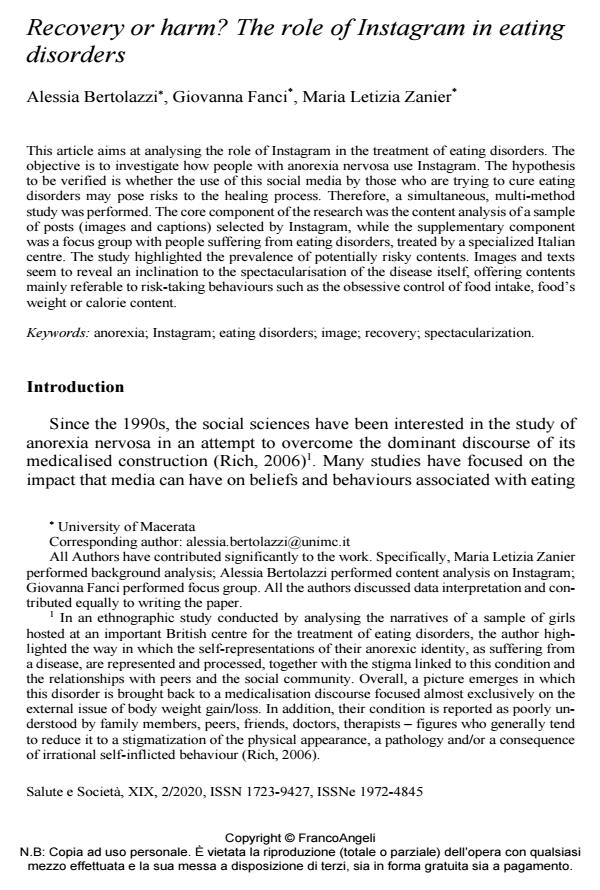Recovery or harm? The role of Instagram in eating disorders
Titolo Rivista SALUTE E SOCIETÀ
Autori/Curatori Alessia Bertolazzi, Giovanna Fanci, Maria Letizia Zanier
Anno di pubblicazione 2020 Fascicolo 2020/2 Lingua Inglese
Numero pagine 14 P. 90-103 Dimensione file 171 KB
DOI 10.3280/SES2020-002007
Il DOI è il codice a barre della proprietà intellettuale: per saperne di più
clicca qui
Qui sotto puoi vedere in anteprima la prima pagina di questo articolo.
Se questo articolo ti interessa, lo puoi acquistare (e scaricare in formato pdf) seguendo le facili indicazioni per acquistare il download credit. Acquista Download Credits per scaricare questo Articolo in formato PDF

FrancoAngeli è membro della Publishers International Linking Association, Inc (PILA)associazione indipendente e non profit per facilitare (attraverso i servizi tecnologici implementati da CrossRef.org) l’accesso degli studiosi ai contenuti digitali nelle pubblicazioni professionali e scientifiche
This article aims at analysing the role of Instagram in the treatment of eating disorders. Theobjective is to investigate how people with anorexia nervosa use Instagram. The hypothesisto be verified is whether the use of this social media by those who are trying to cure eatingdisorders may pose risks to the healing process. Therefore, a simultaneous, multi-methodstudy was performed. The core component of the research was the content analysis of a sampleof posts (images and captions) selected by Instagram, while the supplementary componentwas a focus group with people suffering from eating disorders, treated by a specialized Italiancentre. The study highlighted the prevalence of potentially risky contents. Images and textsseem to reveal an inclination to the spectacularisation of the disease itself, offering contentsmainly referable to risk-taking behaviours such as the obsessive control of food intake, food’sweight or calorie content.
Keywords:Anorexia; Instagram; eating disorders; image; recovery; spectacularization.
- Chesley E.B., Alberts J.D., Klein J.D., Kreipe R.E. (2003). Pro or con? Anorexia nervosa and the Internet. Journal of Adolescent Medicine, 32: 123-124.
- Chou W.Y.S., Hunt Y., Folkers A., Augustson E. (2011). Cancer survivorship in the age of YouTube and social media: a narrative analysis. Journal of Medical Internet Research, 13: e7.
- Fardouly J., Diedrichs P.C., Vartanian L.R., et al. (2015). Social comparisons on social media: the impact of Facebook on young women’s body image concerns and mood. Body Image, 13: 38–45.
- Fardouly J., Willburger B.K., Vartanian L.R. (2018). Instagram use and young women’s body image concerns and self-objectification: Testing mediational pathways. New Media & Society, 20(4): 1380-1395. DOI: 10.1177/146144481769449
- Frisina A. (2010). Focus group. Una guida pratica. Bologna: Il Mulino.
- Frohlich D.O., Zmyslinski-Seelig A. (2012). The presence of social support messages
- on YouTube videos about inflammatory bowel disease and ostomies. Health Communication, 27: 421-428. DOI: 10.1080/10410236.2011.60652
- Ging D., Garvey S. (2018). ‘Written in these Scars Are the Stories I Can’t Explain’: A Content Analysis of Pro-Ana and Thinspiration Image Sharing on Instagram, New Media & Society, 20(3): 1181-1200. DOI: 10.1177/146144481668728
- Halliwell E., Harvey M. (2006). Examination of a sociocultural model of disordered eating among male and female adolescents. British Journal of Health Psychology, 11: 235-248. DOI: 10.1348/135910705X3921
- Kaplan K., Salzer M.S., Solomon P., Brusilovskiy E., Cousounis P. (2011). Internet peer support for individuals with psychiatric disabilities: a randomized controlled trial. Social Science & Medicine, 72: 54-62.
- Keery H., van den Berg P., Thompson J.K. (2004). An evaluation of the tripartite influence model of body dissatisfaction and eating disturbance with adolescent girls. Body Image, 1: 237-251.
- LaMarre A., Rice. C. (2017). Hashtag Recovery: #Eating Disorder Recovery on Instagram. Social Sciences, 6(3): 68.
- Laestadius L. (2016). Instagram. In: Sloan L., Quan-HaaseA., eds., The SAGE Handbook of Social Media Research Methods.London: Sage.
- Mabe A.G., Forney K.J., Keel P.K. (2014). Do you like my photo? Facebook use maintains eating disorder risk. International Journal of Eating Disorders, 47: 516-523.
- Meier E.P., Gray J. (2014). Facebook photo activity associated with body image disturbance in adolescent girls. Cyberpsychology, Behavior, and Social Networking, 17: 199-206.
- Morse J. (2010). Simultaneous and Sequential Qualitative Mixed Method Designs. Qualitative Inquiry, 16: 483-491. DOI: 10.1177/107780041036474
- Musolino C., Warin M., Wade T., Gilchrist P. (2015). ‘Healthy Anorexia’: The complexity of care in disordered eating. Social Science & Medicine, 139: 18-25.
- Norris L.M., Boydell K.M., Pinhas L., Katzman D.K. (2006). Ana and the Internet: A Review of Pro-Anorexia Websites. International Journal of Eating Disorders, 39: 443-447.
- Parrò E., Corposanto C., Aloi M. (2018). Disturbi del comportamento alimentare e influenza dei social network. In: Corposanto C., a cura di, Alimentazione, salute e dintorni. Milano: FrancoAngeli.
- Rich E. (2006). Anorexic dis(connection): managing anorexia as an illness and an identity. Sociology of Health & Illness, 28 (3): 284-305.
- Stice E. (1994). Review of the evidence for a sociocultural model of bulimia nervosa: An explanation of the mechanisms of action. Clinical Psychology Review, 14: 633-661. DOI: 10.1016/0272-7358(94)90002-
- Stice E. (2002). Risk and maintenance factors for eating pathology: a meta-analytic review. Psychological Bulletin, 128: 825–848. DOI: 10.1037/0033-2909.128.5.82
- Thompson J.K., Stice E. (2001). Thin-ideal internalization: mounting evidence for a new risk factor for body-image disturbance and eating pathology. Current Directions in Psychological Science, 10: 181–183. DOI: 10.1111/1467-8721.0014
- Tiggemann M., Slater A. (2013). NetGirls: the Internet, Facebook, and body image concern in adolescent girls. International Journal of Eating Disorders, 46: 630-633.
- Tiggemann M., Slater A. (2014). NetTweens: the Internet and body image concerns in preteenage girls. Journal of Early Adolescence, 34: 606–620. DOI: 10.1177/027243161350108
- Tiggemann M., Zaccardo M. (2015). “Exercise to be fit, not skinny”: The effect of fitspiration imagery on women’s body image. Body Image, 15: 61-67.
- Yom-Tov E., Fernandez-Luque L., Weber I., Crain S.P. (2012). Pro-Anorexia and Pro-Recovery Photo Sharing: A Tale of Two Warring Tribes. Journal of Medical Internet Research, 14(6): e151.
- #Socialfood: Virtuous or vicious? A systematic review Vera Ventura, Alessia Cavaliere, Beatrice Iannò, in Trends in Food Science & Technology /2021 pp.674
DOI: 10.1016/j.tifs.2021.02.018
Alessia Bertolazzi, Giovanna Fanci, Maria Letizia Zanier, Recovery or harm? The role of Instagram in eating disorders in "SALUTE E SOCIETÀ" 2/2020, pp 90-103, DOI: 10.3280/SES2020-002007